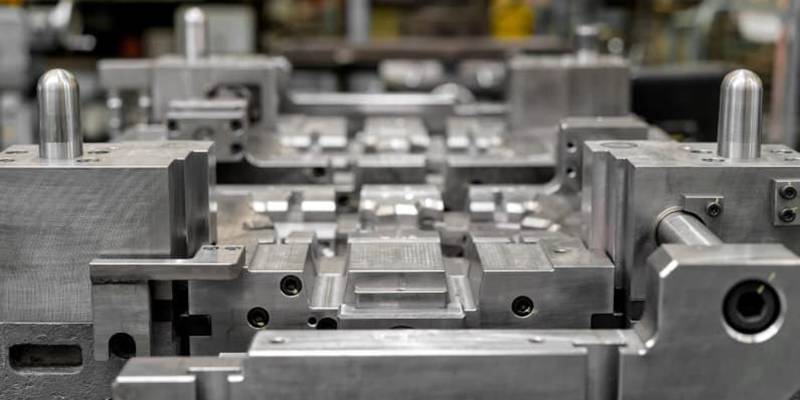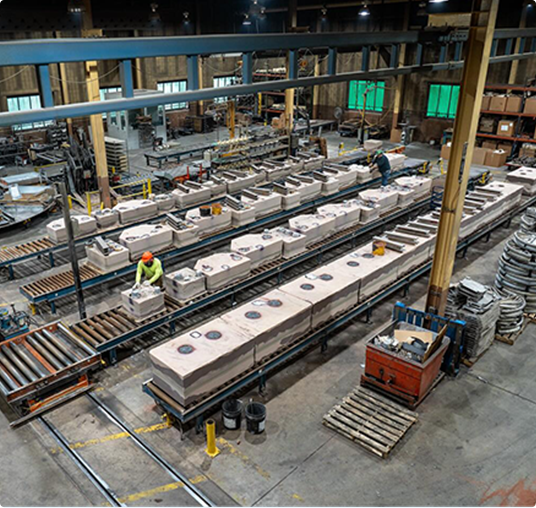The evolution of Aluminum Castings in engineering practices
Wiki Article
The Function of Aluminum Casting in Progressing Lasting Manufacturing Practices
Aluminum casting works as a crucial aspect in promoting lasting manufacturing techniques. Its capability to produce top notch components with a reduced ecological footprint is impressive. The process not only supports power effectiveness however additionally considerably improves recyclability. Nonetheless, difficulties continue to be in completely recognizing its potential. Exploring the technologies in aluminum casting modern technology might reveal remedies that align making with sustainability goals. The effects of these advancements deserve thinking about.Understanding Aluminum Casting and Its Refine
Although aluminum casting has been an essential process in making for decades, its importance proceeds to grow in different sectors as a result of its flexibility and performance. This procedure involves pouring molten aluminum right into molds to create detailed forms and parts, making it perfect for creating light-weight yet resilient items. The aluminum casting procedure can be categorized into a number of techniques, including sand casting, die casting, and investment casting, each offering unique advantages matched to details applications.Throughout the casting procedure, aluminum is heated up to its melting point, enabling it to flow quickly into molds that define the last form. When cooled, the aluminum solidifies, resulting in a solid and exact element. The capability to produce intricate geometries with marginal waste highlights aluminum casting's function in modern production - Aluminum Castings. As sectors seek innovative remedies, recognizing this process becomes important for optimizing manufacturing and satisfying the demands of an advancing market
Ecological Benefits of Aluminum Casting
As sectors progressively prioritize sustainability, the ecological benefits of aluminum casting come to be a lot more pronounced. One substantial benefit is the material's recyclability; aluminum can be reused consistently without degrading its top quality. This decreases the amount of waste sent out to landfills and lessens the need for virgin products, saving natural deposits. Furthermore, the aluminum casting procedure produces less greenhouse gas discharges contrasted to other steel casting techniques, adding to reduced overall ecological effect.Another advantage lies in the light-weight nature of aluminum, which leads to sustain efficiency in transport applications. By making use of aluminum elements, manufacturers can minimize automobile weight, resulting in reduced gas usage and emissions throughout operation. Developments in aluminum casting innovations have actually led to a reduction in dangerous waste manufacturing, improving total ecological security. Jointly, these elements placement aluminum casting as a key player in advertising lasting manufacturing methods and conference ecological goals across different markets.
Power Efficiency in Aluminum Manufacturing
Energy performance plays an important function in aluminum production, considerably affecting general sustainability. By taking on cutting-edge casting strategies and integrating renewable resource resources, suppliers can achieve reduced energy intake throughout the manufacturing procedure. This shift not only lowers operational prices but also adds to a more eco-friendly sector.
Minimized Energy Consumption
While the aluminum production market has actually traditionally been energy-intensive, current improvements have actually greatly boosted power effectiveness throughout the production process. Developments in smelting innovation and the adoption of high-efficiency heating systems have substantially decreased energy consumption. These enhancements enable producers to use much less energy each of result, decreasing greenhouse gas emissions and lowering operational prices. Furthermore, the assimilation of sustainable energy sources right into production facilities additionally adds to decreased reliance on fossil fuels, advertising sustainability. Applying innovative insulation materials and enhancing warm recuperation systems likewise plays a crucial role in making best use of power efficiency. Consequently, the aluminum industry is making considerable strides towards minimizing its overall ecological impact while satisfying the increasing demand for lasting techniques in manufacturing.Innovative Casting Techniques
Cutting-edge casting methods are transforming the aluminum production landscape, enhancing both performance and sustainability. Advanced techniques such as die casting and financial investment casting reduce material waste and enhance dimensional precision, causing reduced power usage throughout the production process. Methods like rapid solidification and semi-solid processing enable better control over metallurgical residential properties, causing light-weight and high-strength parts. Furthermore, the application of computer system simulations and automation in casting processes optimizes cycle times and reduces issue prices. These developments not only simplify production but likewise add to the round economy by enabling the recycling of aluminum scrap into premium items. Because of this, the aluminum sector is positioned to meet expanding needs while sticking to sustainable manufacturing methods.Renewable Resource Assimilation
A significant change in the direction of renewable resource assimilation is reshaping energy effectiveness in aluminum production. This modification entails utilizing solar, wind, and hydropower sources to lower dependence on nonrenewable fuel sources, significantly decreasing carbon emissions. Facilities are significantly taking on energy-efficient innovations, such as innovative electrolytic procedures, which maximize energy consumption during aluminum manufacturing. By harnessing renewable resource, producers not just lower operational prices but additionally improve their sustainability accounts. Additionally, wise grid innovations promote the seamless combination of sustainable sources, permitting more steady power supplies. As the industry accepts these innovations, the aluminum industry is positioned to lead in sustainable practices, showing a commitment to ecological stewardship while satisfying boosting global need for light-weight, high-performance products.The Recyclability of Aluminum and Its Influence
Aluminum's recyclability supplies considerable benefits in lasting manufacturing, enabling infinite recycling without loss of top quality. This residential property not only minimizes waste however likewise enhances power performance throughout the reusing process. Because of this, the impact on both the environment and manufacturing prices is extensive, making aluminum a preferred product in eco-conscious industries.Infinite Recycling Prospective
Although lots of products lose high quality via reusing processes, aluminum attracts attention as a result of its limitless recyclability, which considerably adds to lasting production techniques. This special characteristic allows aluminum to be reused repetitively without weakening its residential properties, making it a useful resource in different sectors. The lifecycle of aluminum starts once again with each recycling initiative, conserving resources and reducing waste. This not just decreases the environmental impact however additionally fosters a round economic climate where aluminum can be recycled countless times. The high need for recycled aluminum better emphasizes its importance in sustainable production, as it enhances source performance and advertises a green approach to production. Eventually, the unlimited reusing potential of aluminum plays a considerable duty beforehand lasting practices throughout industries.
Energy Efficiency Benefits
Substantial power savings are recognized with the recycling of aluminum, highlighting its duty in lasting production. Recycling aluminum needs only 5% of the energy required to produce brand-new aluminum from basic materials. This considerable decrease in power consumption equates into lower greenhouse gas emissions, adding to ecological sustainability. The energy effectiveness of aluminum recycling not just conserves resources however likewise reduces operational expenses for makers, making it an economically feasible alternative. In addition, the process of reusing aluminum can be incorporated right into existing assembly line without considerable disturbance, improving general performance. As markets significantly focus on sustainability, the recyclability of aluminum settings it as a principal in advancing energy-efficient manufacturing practices, cultivating a circular economy and advertising responsible source administration.Challenges Encountering Aluminum Casting in Sustainable Practices
While the aluminum casting sector has actually made strides in the direction of lasting practices, a number of obstacles remain that impede its progression. One substantial issue is the high power consumption associated with typical casting techniques, which typically depends on nonrenewable fuel sources. This reliance not only boosts functional prices yet additionally adds to greenhouse gas discharges. In addition, the recycling process for aluminum can be inefficient, causing material loss and raised waste. Another challenge is the minimal availability of sustainable resources, as sourcing recycled aluminum can be hard and costly. Moreover, regulatory pressures and varying ecological standards across areas make complex compliance initiatives, making it challenging for firms to take on consistent lasting methods. Finally, workforce training continues to be inadequate, with numerous workers doing not have the essential skills to implement ingenious, green methods in casting processes. Dealing with these obstacles is necessary for the aluminum casting industry to fully realize its possibility in lasting production.Developments in Aluminum Casting Innovation
To conquer the obstacles encountered in lasting methods, the aluminum casting industry is observing a wave of technologies focused on boosting performance and reducing ecological effect. Advanced casting approaches, such as 3D printing and die casting, are being taken on to lessen product waste and enhance accuracy. These innovations make it possible for makers to create complicated geometries with much less aluminum, therefore preserving resources.Additionally, the integration of reusing methods, including closed-loop systems, assists in the use of scrap aluminum, significantly minimizing energy usage compared to primary aluminum production. Enhanced mold designs and coverings are also adding to sustainability by improving thermal performance and reducing emissions throughout the casting process.
Automation and clever manufacturing technologies are being carried out to enhance manufacturing processes, Aluminum Castings resulting in minimized cycle times and energy usage. Collectively, these innovations stand for a considerable shift in the direction of even more lasting methods within the aluminum casting field, aligning with more comprehensive environmental objectives.
Future Leads for Lasting Production With Aluminum Casting
As the need for lasting manufacturing practices heightens, the aluminum casting sector is positioned to play a critical role in shaping a greener future. The sector is progressively taking on reusing procedures that considerably lower waste and energy intake, aligning with worldwide sustainability goals. Technologies such as low-energy casting strategies and using recycled aluminum not only minimize carbon impacts yet also enhance the general effectiveness of production.

As industries seek to adhere to stricter ecological regulations, the aluminum casting market stands all set to offer lasting remedies, positioning itself as a principal in the shift towards eco-friendly manufacturing techniques in various industries, consisting of auto and aerospace.
Frequently Asked Concerns
Just How Does Aluminum Casting Contrast to Other Metal Casting Techniques?
Aluminum casting usually offers advantages such as lower melting factors and premium recyclability contrasted to other metal casting methods. Its lightweight nature and exceptional deterioration resistance further enhance its charm in different production applications.What Industries Advantage The Majority Of From Aluminum Casting?
Various industries, including automobile, aerospace, and durable goods, substantially advantage from aluminum casting - Aluminum Castings. This approach's light-weight, corrosion-resistant residential properties boost product performance while allowing for elaborate styles, making it an appealing choice for makers looking for effectiveness and technologyCan Aluminum Casting Be Made Use Of for Facility Styles?
Aluminum casting can successfully suit complicated styles because of its adaptability and capability to develop elaborate shapes. This procedure makes it possible for suppliers to develop light-weight, long lasting elements appropriate for different applications across different sectors, boosting advancement and effectiveness.What Is the Lifespan of Aluminum Cast Products?
The life expectancy of aluminum cast items normally varies from a number of years to over a century, relying on aspects such as ecological conditions, upkeep, and the details application. Longevity makes them appropriate for different long-term usages.Exactly How Does Aluminum Casting Effect Job Creation in Manufacturing?
Aluminum casting considerably adds to task development in manufacturing by cultivating knowledgeable labor chances, supporting local economic situations, and encouraging technical innovations. This process not only boosts production performance but additionally advertises workforce advancement and training initiatives.Report this wiki page